Effect of Water-Based Emulsion Core Microcapsules on Aging Resistance and Self-Repairing Properties of Water-Based Coatings on Linden
Abstract
:1. Introduction
2. Materials and Methods
2.1. Experimental Materials
2.2. Experimental Method
2.3. Testing and Characterization
3. Results and Discussion
3.1. SEM and FT-IR of the Microcapsules
3.2. Effect of Coating Technology on Optical Performance
3.3. Effect of Coating Technology on Mechanical Performance
3.4. Aging Resistance Test of Water-Based Coating Film with Microcapsules
3.5. Self Repairing Performance of Water-Based Coating Film with Microcapsules
3.6. Comparison of Self-Repairing Properties of Dulux Water-Based Emulsion Microcapsules and Nippon Water-Based Emulsion Microcapsules
4. Conclusions
Author Contributions
Funding
Institutional Review Board Statement
Informed Consent Statement
Data Availability Statement
Conflicts of Interest
References
- Gao, J.; Wang, R.; Zhang, Z.M.; Song, D.D.; Li, X.G. Effect of membrane structure of waterborne coatings on the transport process of corrosive medium. Prog. Org. Coat. 2018, 124, 8–15. [Google Scholar]
- Miklecic, J.; Blagojevic, S.L.; Petric, M.; Jirous-Rajkovic, V. Influence of TiO2 and ZnO nanoparticles on properties of waterborne polyacrylate coating exposed to outdoor conditions. Prog. Org. Coat. 2015, 89, 67–74. [Google Scholar]
- Tang, G.W.; Ren, T.T.; Yan, Z.S.; Ma, L.R.; Pan, X.H.; Liu, J.; Hou, X.Y.; Huang, X. Corrosion resistance of a self-curing waterborne epoxy resin coating. J. Coat. Technol. Res. 2019, 16, 895–904. [Google Scholar]
- Yan, X.X.; Wang, L.; Qian, X.Y. Effect of coating process on performance of reversible thermochromic waterborne coatings for Chinese fir. Coatings 2020, 10, 223. [Google Scholar]
- Liu, Q.Q.; Gao, D.; Xu, W. Effect of sanding processes on the surface properties of modified Poplar coated by primer compared with Mahogany. Coatings 2020, 10, 856. [Google Scholar]
- Hwang, H.D.; Moon, J.I.; Choi, J.H.; Kim, H.J.; Do Kim, S.; Park, J.C. Effect of water drying conditions on the surface property and morphology of waterborne UV-curable coatings for engineered flooring. J. Ind. Eng. Chem. 2009, 15, 381–387. [Google Scholar]
- Kong, L.L.; Xu, D.D.; He, Z.X.; Wang, F.Q.; Gui, S.H.; Fan, J.L.; Pan, X.Y.; Dai, X.H.; Dong, X.Y.; Liu, B.X.; et al. Nanocellulose-reinforced polyurethane for waterborne wood coating. Molecules 2019, 24, 3151. [Google Scholar]
- Liu, M.; Mao, X.H.; Zhu, H.; Lin, A.; Wang, D.H. Water and corrosion resistance of epoxy-acrylic-amine waterborne coatings: Effects of resin molecular weight, polar group and hydrophobic segment. Corros. Sci. 2013, 75, 106–113. [Google Scholar]
- Qi, Y.Q.; Shen, L.M.; Zhang, J.L.; Yao, J.; Lu, R.; Miyakoshi, T. Species and release characteristics of VOCs in furniture coating process. Environ. Pollut. 2019, 245, 810–819. [Google Scholar]
- Xiong, X.Q.; Yuan, Y.Y.; Niu, Y.T.; Zhang, L.T. Development of a cornstarch adhesive for laminated veneer lumber bonding for use in engineered wood flooring. Int. J. Adhes. Adhes. 2020, 98, 102534. [Google Scholar]
- Zhang, T.X.; Ting, G.; Wu, Z.H.; Sun, T. Reinforced strength evaluation of binding material for the restoration of Chinese ancient lacquer furniture. BioResources 2019, 14, 7182–7192. [Google Scholar]
- Xu, W.; Fang, X.Y.; Han, J.T.; Wu, Z.H.; Zhang, J.L. Effect of coating thickness on sound absorption property of four wood species commonly used for piano soundboards. Wood Fiber. Science 2020, 52, 28–43. [Google Scholar]
- Liu, X.Y.; Timar, M.C.; Varodi, A.M. A comparative study on the artificial UV and natural ageing of beeswax and Chinese wax and influence of wax finishing on the ageing of Chinese Ash (Fraxinus mandshurica) wood surfaces. J. Photoch. Photobio. B 2019, 201, 111607. [Google Scholar]
- Qiao, J.C.; Ha, X.L.; Guan, P.; Zhao, Y.; Tian, W. Preparation and development of pharmaceutical microcapsules. Prog. Chem. 2008, 20, 171–181. [Google Scholar]
- Althaqafi, K.A.; Satterthwaite, J.; Silikas, N. A review and current state of autonomic self-healing microcapsules-based dental resin composites. Dent. Mater. 2020, 36, 329–342. [Google Scholar]
- Parsaee, S.; Mirabedini, S.M.; Farnood, R.; Alizadegan, F. Development of self-healing coatings based on urea-formaldehyde/polyurethane microcapsules containing epoxy resin. J. Appl. Polym. Sci. 2020, 137, e49663. [Google Scholar]
- Njoku, C.N.; Bai, W.C.; Arukalam, I.O.; Yang, L.H.; Hou, B.R.; Njoku, D.I.; Li, Y. Epoxy-based smart coating with self-repairing polyurea-formaldehyde microcapsules for anticorrosion protection of aluminum alloy AA2024. J. Coat. Technol. Res. 2020, 17, 797–813. [Google Scholar]
- Chen, S.S.; Han, T.; Zhao, Y.; Luo, W.J.; Zhang, Z.; Su, H.B.; Tang, B.Z.; Yang, J.L. A facile strategy to prepare smart coatings with autonomous self-healing and self-reporting functions. ACS Appl. Mater. Inter. 2020, 12, 4870–4877. [Google Scholar]
- Zhang, H.; Zhang, X.; Bao, C.L.; Li, X.; Duan, F.; Friedrich, K.; Yang, J.L. Skin-inspired, fully autonomous self-warning and self-repairing polymeric material under damaging events. Chem. Mater. 2019, 31, 2611–2618. [Google Scholar]
- Shang, B.; Chen, M.; Wu, L.M. Fabrication of UV-triggered liquid-repellent coatings with long-term self-repairing performance. ACS Appl. Mater. Inter. 2018, 10, 31777–31783. [Google Scholar]
- Chen, K.L.; Gu, K.; Qiang, S.Y.; Wang, C.X. Environmental stimuli-responsive self-repairing waterbased superhydrophobic coatings. RSC. Adv. 2017, 7, 543–550. [Google Scholar]
- Chen, S.W.; Lu, X.C.; Wang, T.Z.; Zhang, Z.M. Preparation and characterization of urea-formaldehyde resin/reactive kaolinite composites. Particuology 2016, 24, 203–209. [Google Scholar]
- Duan, Y.F.; Huo, Y.D.; Duan, L. Preparation of acrylic resins modified with epoxy resins and their behaviors as binders of waterborne printing ink on plastic film. Colloid. Surf. A 2017, 535, 225–231. [Google Scholar]
- Guo, X.K.; Ge, S.S.; Wang, J.X.; Zhang, X.C.; Zhang, T.; Lin, J.; Zhao, C.X.X.; Wang, B.; Zhu, G.F.; Guo, Z.H. Waterborne acrylic resin modified with glycidyl methacrylate (GMA): Formula optimization and property analysis. Polymer 2018, 143, 155–163. [Google Scholar]
- Yan, X.X.; Zhao, W.T.; Qian, X.Y. Effect of urea-formaldehyde (UF) with waterborne emulsion microcapsules on properties of waterborne acrylic coatings based on coating process for American Lime. Appl. Sci. 2020, 10, 6341. [Google Scholar]
- GB/T 3181-1995. Colour Standard for Paint Film; Standardization Administration of the People’s Republic of China: Beijing, China, 1995. [Google Scholar]
- GB/T 4893.6-2013. Test of Surface Coatings of Furniture-Part 6: Determination of Gloss Value; Standardization Administration of the People’s Republic of China: Beijing, China, 2013. [Google Scholar]
- GB/T 6739-2006. Paints and Varnishes-Determination of Film Hardness by Pencil Test; Standardization Administration of the People’s Republic of China: Beijing, China, 2006. [Google Scholar]
- GB/T 4893.4-2013. Test of Surface Coatings of Furniture-Part 4: Determination of Adhesion-Cross Cut; Standardization Administration of the People’s Republic of China: Beijing, China, 2013. [Google Scholar]
- GB/T 1732-1993. Determination of Impact Resistance of Film; Standardization Administration of the People’s Republic of China: Beijing, China, 1993. [Google Scholar]
- ASTMD 882-02 Standard. Test Method for Tensile Properties of Thin Plastic Sheeting; ASTM International: West Conshohocken, PA, USA, 2002. [Google Scholar]
- GB/T 23987-2009. Paints and Varnishes-Exposure of Coatings to Artificial Weathering-Exposure to Fluorescent UV Lamps and Water; Standardization Administration of the People’s Republic of China: Beijing, China, 2009. [Google Scholar]
- Popovic, M.; Miljkovic, J.; Simendic, J.B.; Pavlicevic, J.; Ristic, I. Curing characteristics of low emission urea-formaldehyde adhesive in the presence of wood. Wood Res. 2011, 56, 589–600. [Google Scholar]
- Farrokhpay, S.; Morris, G.E.; Fornasiero, D.; Self, P. Titania pigment particles dispersion in water-based paint films. JCT Res. 2006, 3, 275–283. [Google Scholar]
- Li, R.R.; Chen, J.J.; Wang, X.D. Prediction of the color variation of moso bamboo during CO2 laser thermal modification. BioResources 2020, 15, 5049–5057. [Google Scholar]
- Liu, Y.; Hu, J.; Wu, Z.H. Fabrication of coatings with structural color on a wood surface. Coatings 2020, 10, 32. [Google Scholar]
- Feng, G.Y.; Wang, X.Y.; Zhang, D.T.; Xiao, X.L.; Qian, K. Fabrication of bilayer antioxidant microcapsule and evaluation of its efficiency in stabilization of polypropylene. Mater. Res. Express 2019, 6, 125327. [Google Scholar]
- Nesterova, T.; Dam-Johansen, K.; Pedersen, L.T.; Kiil, S. Microcapsule-based self-healing anticorrosive coatings: Capsule size, coating formulation, and exposure testing. Prog. Org. Coat. 2012, 75, 309–318. [Google Scholar]
- Yan, X.X.; Chang, Y.J. Investigation of waterborne thermochromic topcoat film with color-changing microcapsules on Chinese fir surface. Prog. Org. Coat. 2019, 136, 105262. [Google Scholar]
- Chen, H.; Zhang, Y.T.; Yang, X.; Ji, H.; Zhong, T.H.; Wang, G. A comparative study of the microstructure and water permeability between flattened bamboo and bamboo culm. J. Wood Sci. 2019, 65, 64. [Google Scholar]
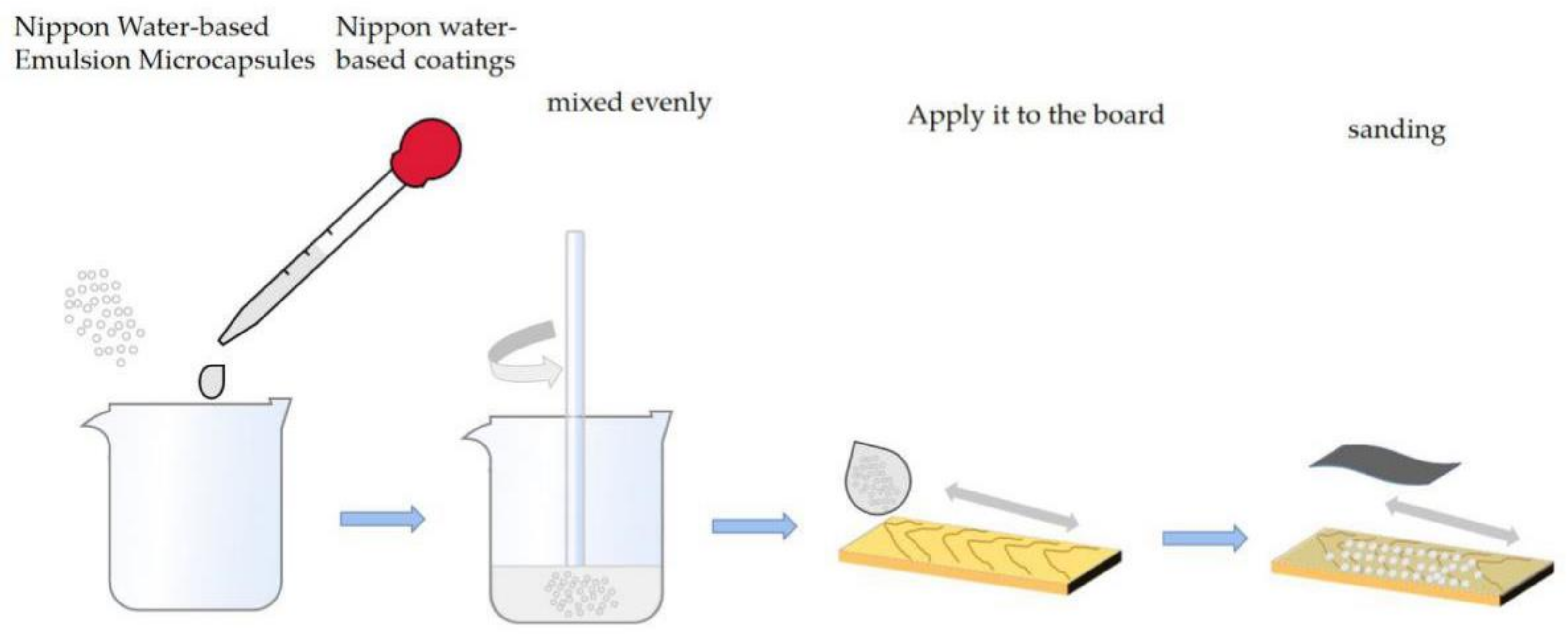

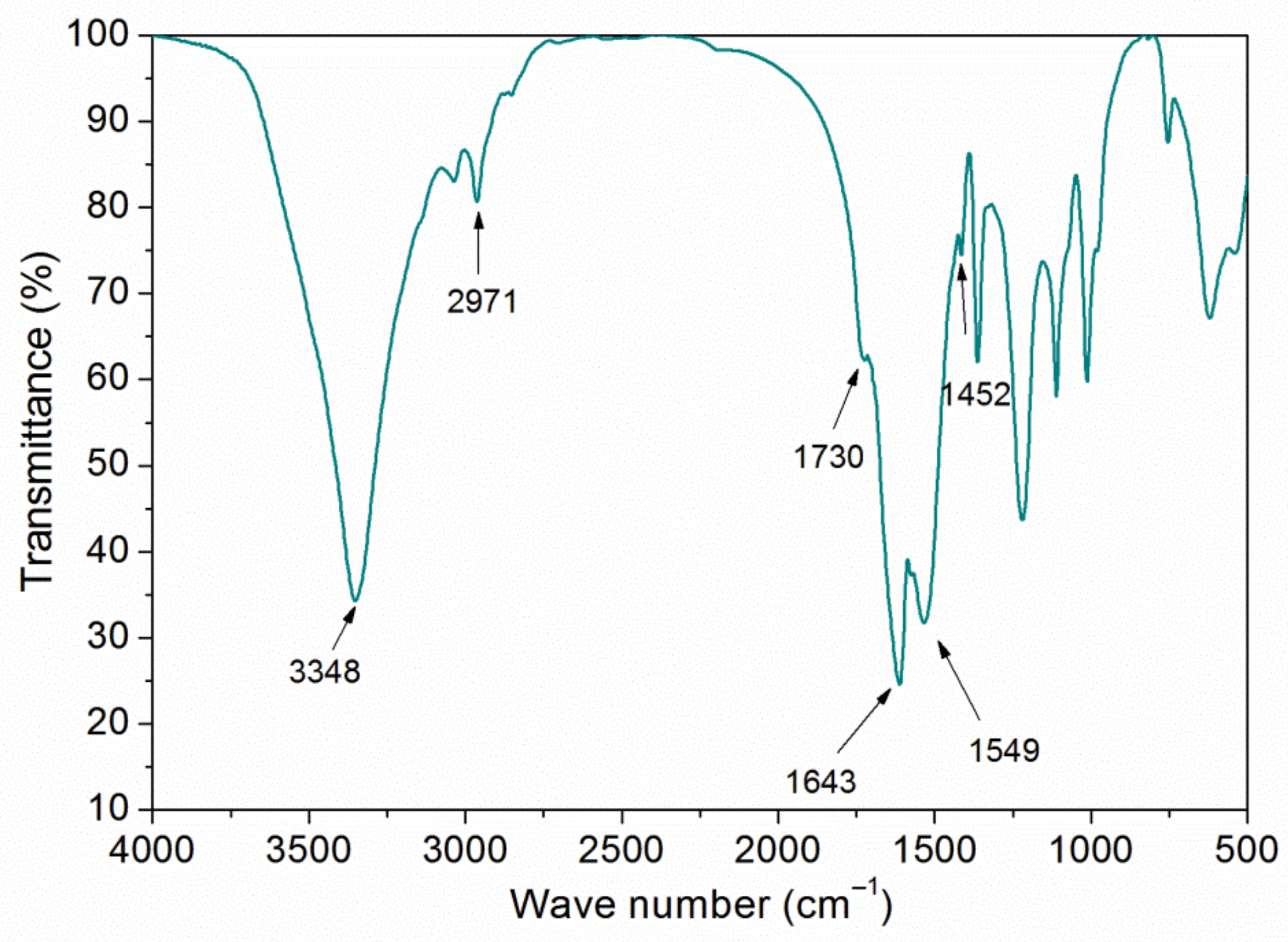

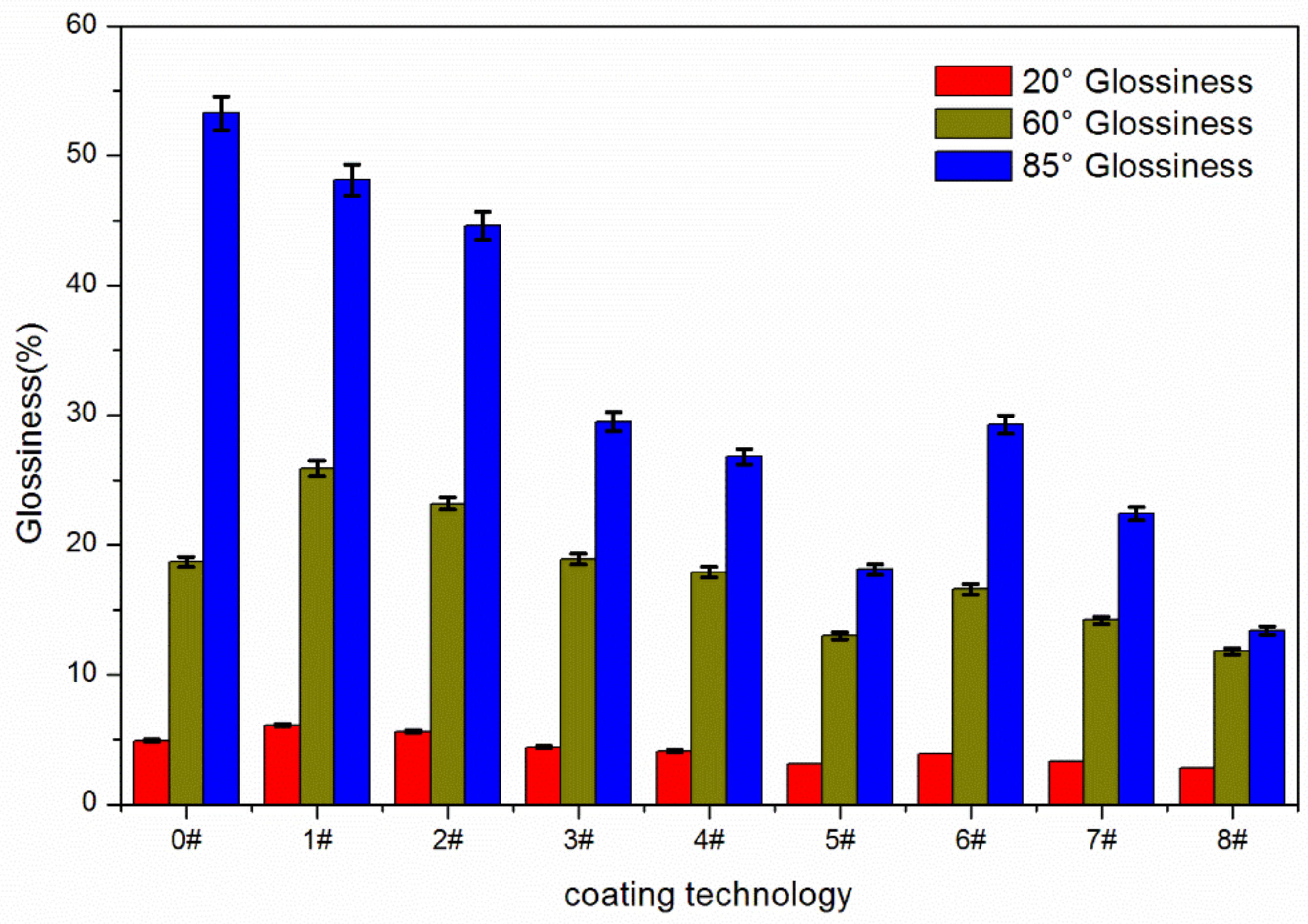
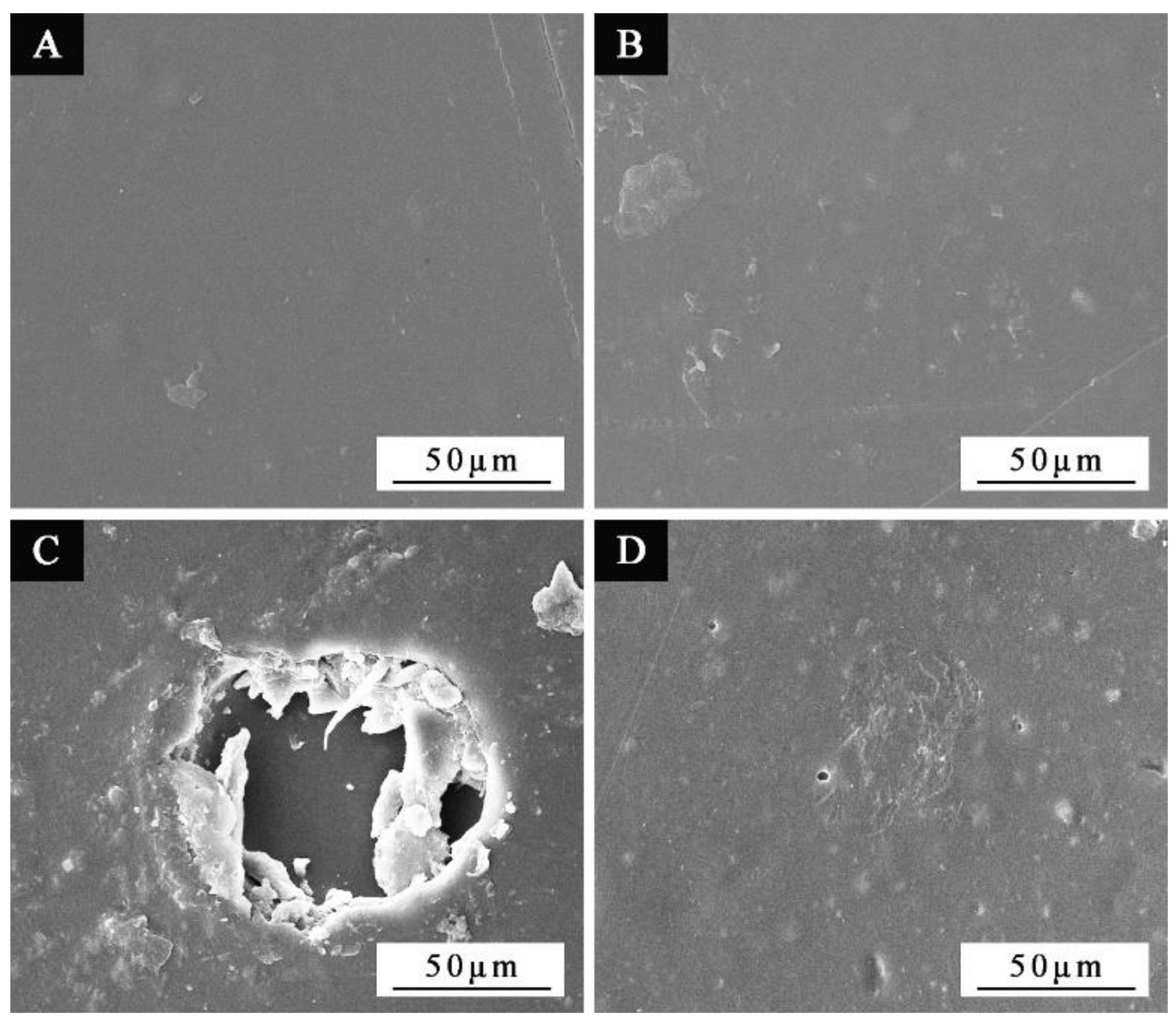
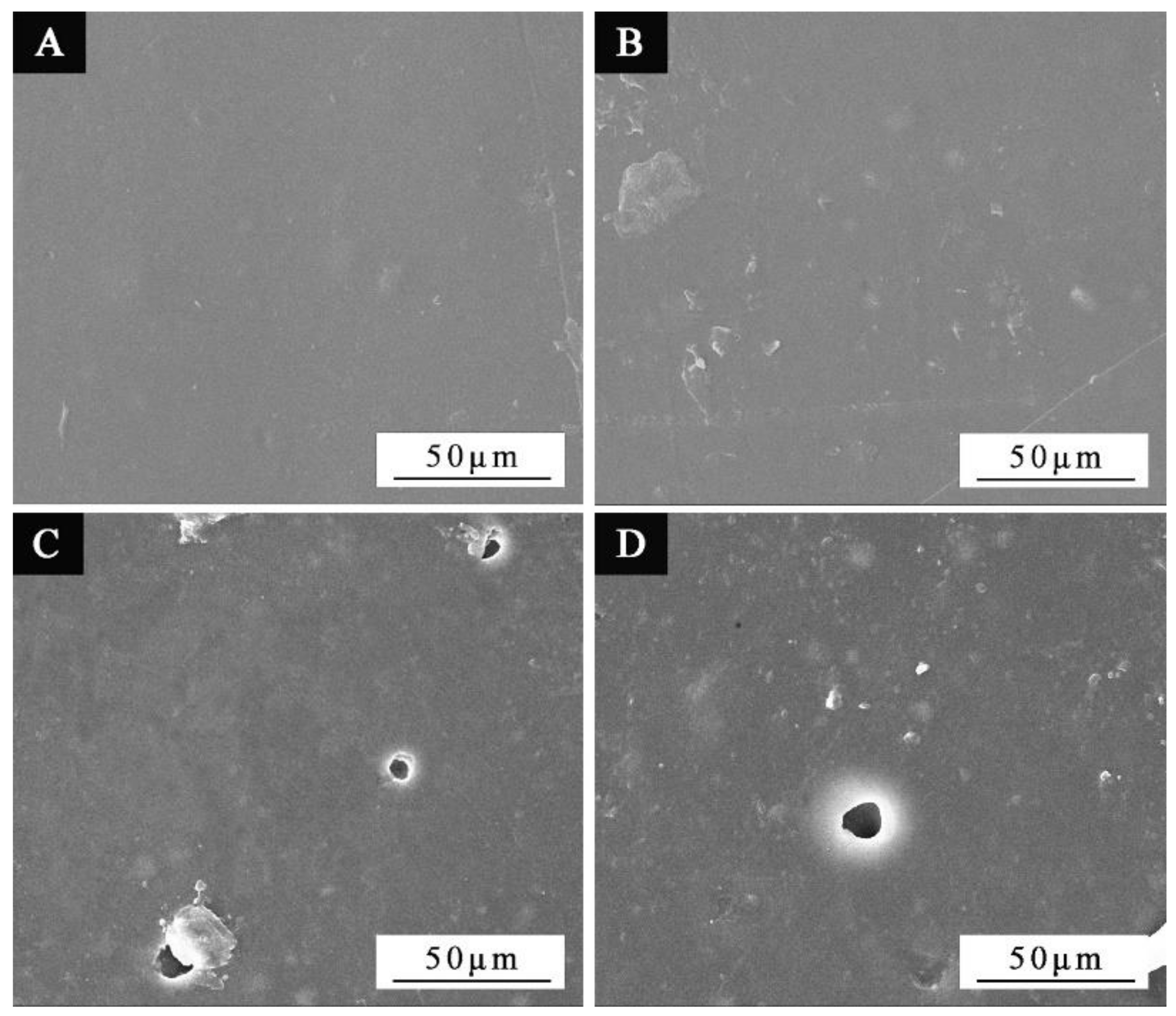
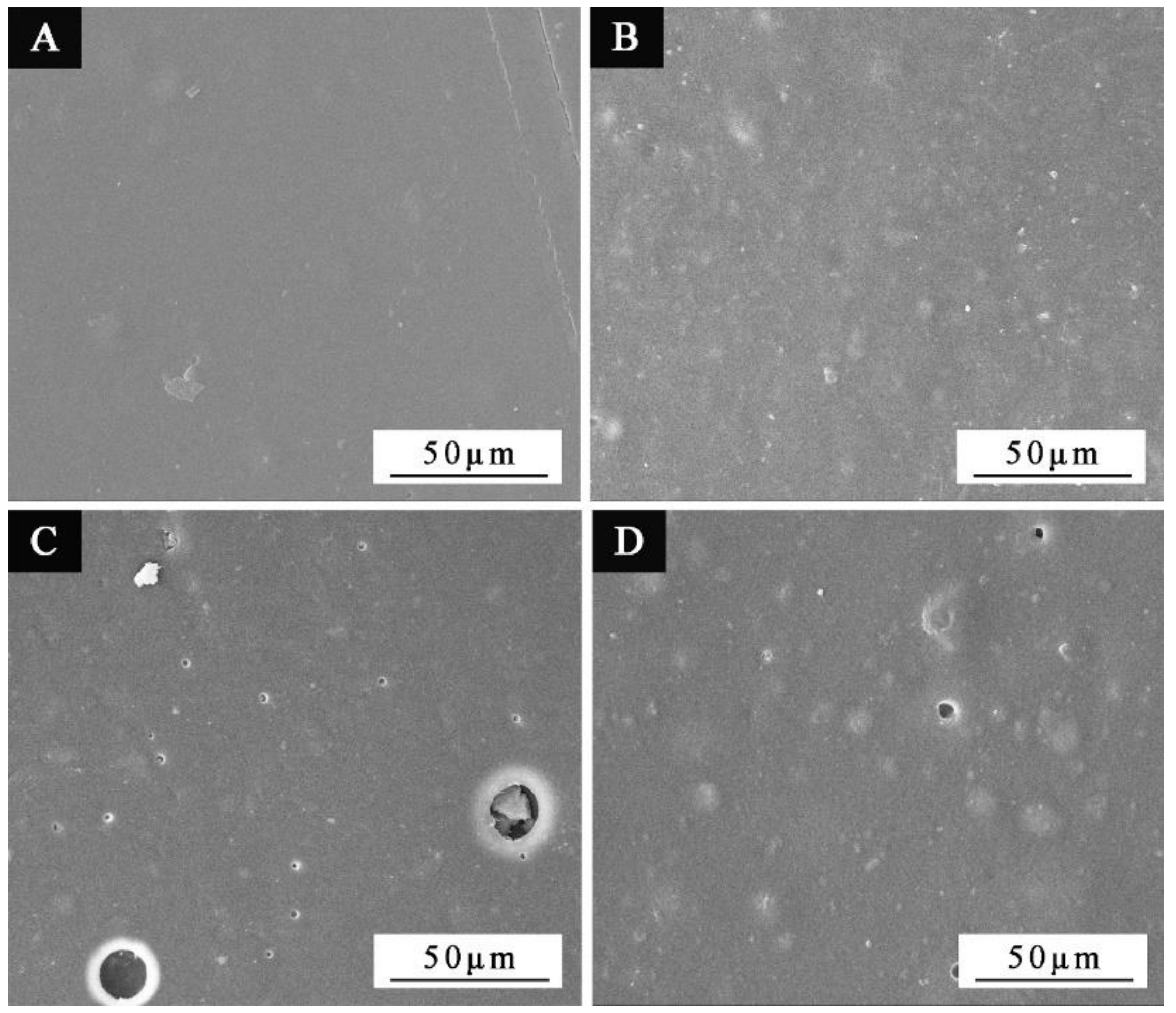
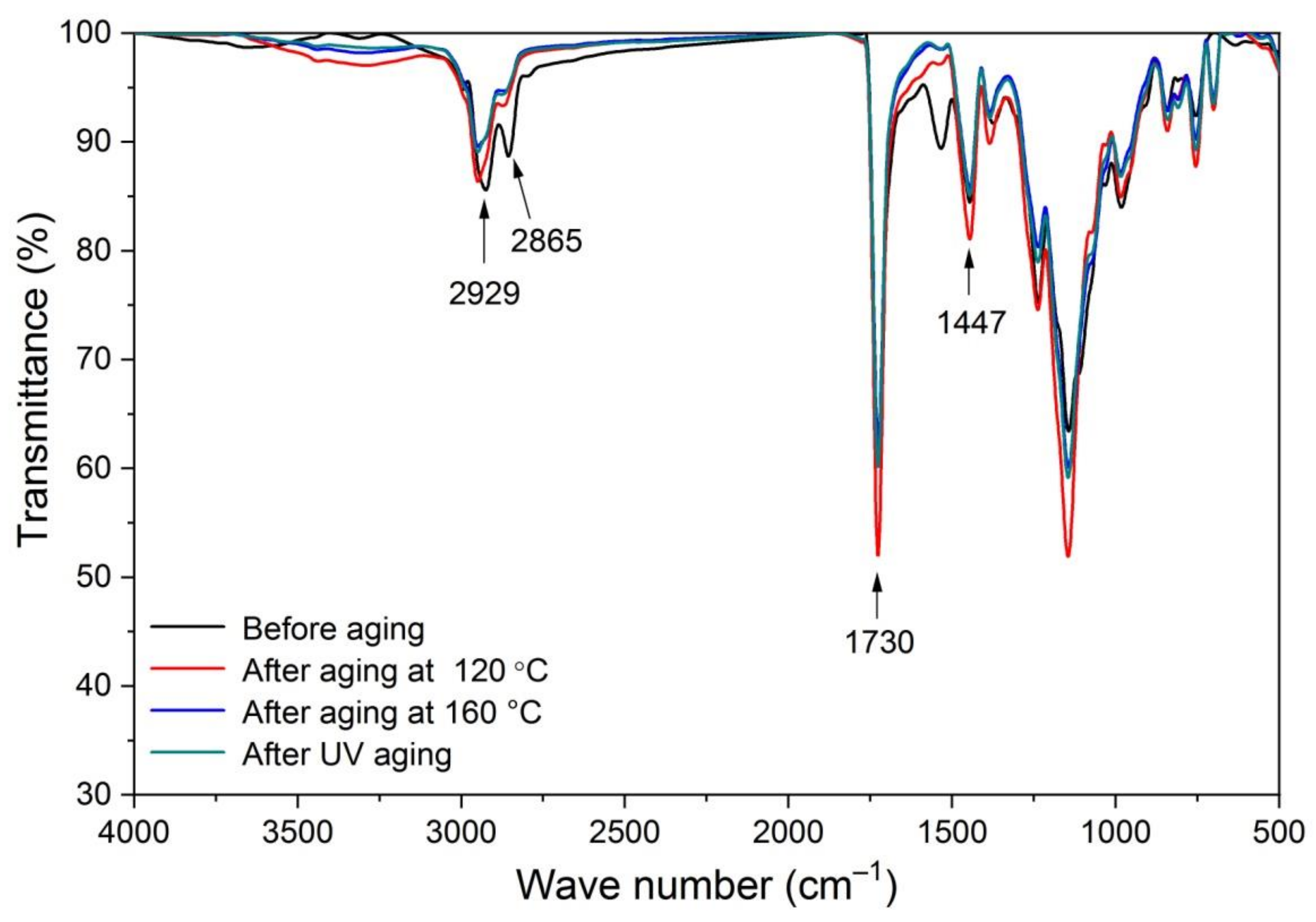
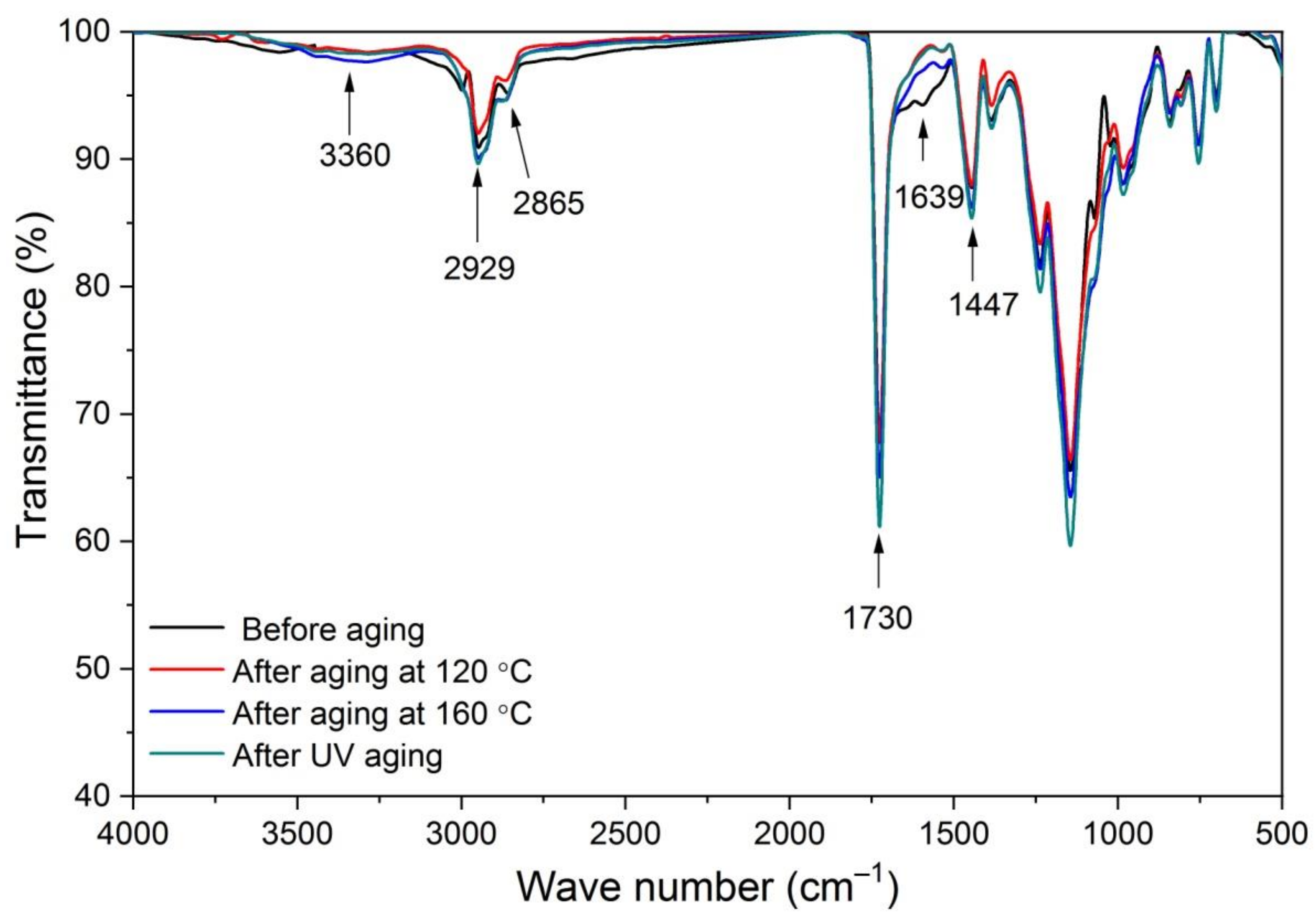


| Materials | Manufacturer |
|---|---|
| 37.0% formaldehyde (Mw: 30.03 g/mol, CAS No.: 50-00-0) | Shandong Baiqian Chemical Co., Ltd., Shandong, China. |
| Urea (Mw: 60.06 g/mol, CAS No.: 57-13-6) | Wuxi Yatai United Chemical Co., Ltd., Wuxi, China. |
| Triethanolamine (Mw: 149.18, CAS No.: 102-71-6) | Wuxi Yatai United Chemical Co., Ltd., Wuxi, China. |
| Sodium dodecyl benzene sulfonate (Mw: 348.48 g/mol, CAS No.: 25155-30-0) | Wuxi Yatai United Chemical Co., Ltd., Wuxi, China. |
| Acetic acid (Mw: 60.05 g/mol, CAS No.: 64-19-7) | Jinan Qiwei Chemical Co., Ltd., Jinan, China. |
| Linden | Feixian Chengyin Wood Industry Co., Ltd., Linyi, China. |
| Nippon water-based coatings | Nippon Coatings Co., Ltd., Shanghai, China. |
| SZQ tetrahedral fabricator | Shenzhen Sanli Technology Co., Ltd., Shenzhen, China. |
| Sample Number | Primer (Number of Depositions) | Topcoat (Number of Depositions) | Ways of Adding Microcapsules |
|---|---|---|---|
| 1 | 2 | 2 | primer |
| 2 | 2 | 3 | primer |
| 3 | 3 | 2 | primer |
| 4 | 3 | 3 | primer |
| 5 | 2 | 2 | topcoat |
| 6 | 2 | 3 | topcoat |
| 7 | 3 | 2 | topcoat |
| 8 | 3 | 3 | topcoat |
| Sample Number | Mass of Microcapsules (g) | Mass of Water-Based Primer (g) | Mass of Water-Based Topcoat (g) |
|---|---|---|---|
| 1 | 2.0 | 18.0 | 20.0 |
| 2 | 2.0 | 18.0 | 20.0 |
| 3 | 2.0 | 18.0 | 20.0 |
| 4 | 2.0 | 18.0 | 20.0 |
| 5 | 2.0 | 20.0 | 18.0 |
| 6 | 2.0 | 20.0 | 18.0 |
| 7 | 2.0 | 20.0 | 18.0 |
| 8 | 2.0 | 20.0 | 18.0 |
| Experimental Instrument | Manufacturer |
|---|---|
| Quanta 200 environment scanning electron microscopy (SEM) | FEI Company, Hillsboro, OR, USA. |
| VERTEX 80V infrared spectrum analyzer (FTIR) | Germany BRUKER Co., Ltd., Karlsruhe, Germany. |
| 3NH portable color aberration meter | Shanghai Gehong Instrument Co., Ltd., Shanghai, China. |
| 3NH intelligent gloss meter | Shanghai Gehong Instrument Co., Ltd., Shanghai, China. |
| Pencil hardness tester | Guangzhou Huazhi Instrument Co., Ltd., Guangzhou, China. |
| HGQ film scratch tester | Guangzhou Xinyi laboratory equipment Co., Ltd., Guangzhou, China. |
| QCJ impactor tester | Shenzhen Haoshunda Machinery Co., Ltd., Shenzhen, China. |
| ZCW-WL precision universal mechanical testing machine | Jinan Zhongchuang Industrial Test System Co., Ltd., China. |
| ZN ultraviolet weather resistance test chamber | Dongguan Jiedong Experimental Equipment Co., Ltd., Dongguan, China. |
| 202-0AB electric heating constant temperature drying oven | Tianjin taist Instrument Co., Ltd., Tianjin., China. |
| Sample Number | Hardness | Adhesion (grade) | Shock Resistance (kg·cm) | Fracture Elongation (%) |
|---|---|---|---|---|
| 0 | HB ± 0 | 0 ± 0 | 6.0 ± 0.1 | 7.6 ± 0.1 |
| 1 | 2H ± 0 | 0 ± 0 | 10.0 ± 0.2 | 13.9 ± 0.3 |
| 2 | 3H ± 0 | 0 ± 0 | 12.0 ± 0.3 | 26.3 ± 0.6 |
| 3 | 2H ± 0 | 0 ± 0 | 11.0 ± 0.2 | 24.4 ± 0.6 |
| 4 | 2H ± 0 | 0 ± 0 | 10.0 ± 0.2 | 14.9 ± 0.3 |
| 5 | 2H ± 0 | 1 ± 0 | 10.0 ± 0.2 | 15.6 ± 0.3 |
| 6 | 3H ± 0 | 0 ± 0 | 10.0 ± 0.2 | 17.9 ± 0.4 |
| 7 | 3H ± 0 | 1 ± 0 | 10.0 ± 0.2 | 26.5 ± 0.6 |
| 8 | 2H ± 0 | 0 ± 0 | 11.0 ± 0.2 | 24.4 ± 0.6 |
| Aging at 120 °C | Aging at 160 °C | |||
|---|---|---|---|---|
| Aging Time (h) | Coating Film with Microcapsule | Coating Film without Microcapsule | Coating Film with Microcapsule | Coating Film without Microcapsule |
| 0 | 0 | 0 | 0 | 0 |
| 8 | 0.5 | 0.9 | 3.3 | 3.4 |
| 16 | 1.4 | 1.9 | 4.8 | 4.9 |
| 24 | 1.8 | 2.2 | 9.3 | 11.8 |
| 32 | 1.9 | 2.9 | 11.5 | 14.9 |
| 40 | 2.2 | 3.5 | 13.1 | 17.1 |
| Aging Time (h) | Coating Film with Microcapsule | Coating Film without Microcapsule |
|---|---|---|
| 0 | 0 | 0 |
| 40 | 1.5 | 2.3 |
| 80 | 2.1 | 5.1 |
| 120 | 3.3 | 5.6 |
| 160 | 3.5 | 5.9 |
| 200 | 4.2 | 6.2 |
| Aging at 120 °C | Aging at 160 °C | |||
|---|---|---|---|---|
| Aging Time (h) | Coating Film with Microcapsule | Coating Film without Microcapsule | Coating Film with Microcapsule | Coating Film without Microcapsule |
| 0 | 34.1 | 66.5 | 23.8 | 48.9 |
| 8 | 33.7 | 65.6 | 23.8 | 48.4 |
| 16 | 33.5 | 65.0 | 23.7 | 47.4 |
| 24 | 33.4 | 64.3 | 23.9 | 45.4 |
| 32 | 33.3 | 63.9 | 23.5 | 45.3 |
| 40 | 33.2 | 63.3 | 23.4 | 44.2 |
| Aging Time (h) | Coating Film with Microcapsule | Coating Film without Microcapsule |
|---|---|---|
| 0 | 29.5 | 49.1 |
| 40 | 29.0 | 48.3 |
| 80 | 28.7 | 48.0 |
| 120 | 28.8 | 47.2 |
| 160 | 28.1 | 46.1 |
| 200 | 28.4 | 46.1 |
Publisher’s Note: MDPI stays neutral with regard to jurisdictional claims in published maps and institutional affiliations. |
© 2021 by the authors. Licensee MDPI, Basel, Switzerland. This article is an open access article distributed under the terms and conditions of the Creative Commons Attribution (CC BY) license (https://creativecommons.org/licenses/by/4.0/).
Share and Cite
Yan, X.; Zhao, W.; Qian, X. Effect of Water-Based Emulsion Core Microcapsules on Aging Resistance and Self-Repairing Properties of Water-Based Coatings on Linden. Appl. Sci. 2021, 11, 4662. https://doi.org/10.3390/app11104662
Yan X, Zhao W, Qian X. Effect of Water-Based Emulsion Core Microcapsules on Aging Resistance and Self-Repairing Properties of Water-Based Coatings on Linden. Applied Sciences. 2021; 11(10):4662. https://doi.org/10.3390/app11104662
Chicago/Turabian StyleYan, Xiaoxing, Wenting Zhao, and Xingyu Qian. 2021. "Effect of Water-Based Emulsion Core Microcapsules on Aging Resistance and Self-Repairing Properties of Water-Based Coatings on Linden" Applied Sciences 11, no. 10: 4662. https://doi.org/10.3390/app11104662
APA StyleYan, X., Zhao, W., & Qian, X. (2021). Effect of Water-Based Emulsion Core Microcapsules on Aging Resistance and Self-Repairing Properties of Water-Based Coatings on Linden. Applied Sciences, 11(10), 4662. https://doi.org/10.3390/app11104662





